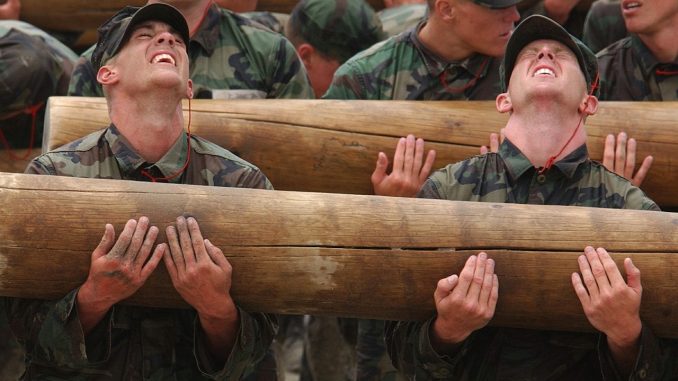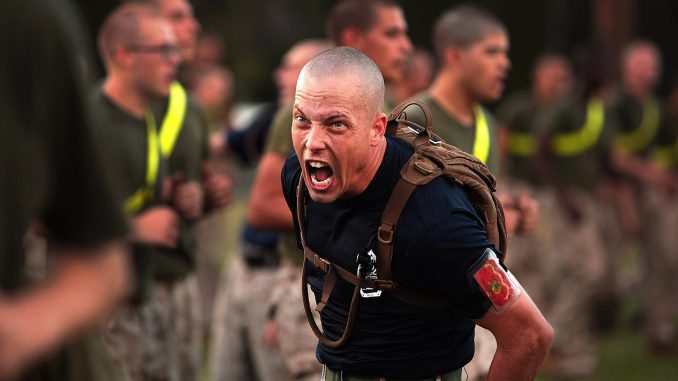Always feeling groggy in the morning? Even after hitting the snooze button numerous times?
What if there was something you could do, right after waking up, that would shake off your sleepiness? To be able to start your day feeling pumped and productive. That’d be great, wouldn’t it?
This underestimated method, I’m talking about, is used by some militaries around the world. Though different in name and structure, they adhere to the same principle. And you can definitely apply this to your daily life to combat morning grogginess.
Combating Morning Sleepiness the Military Way
When I was a recruit in the SAF (Singapore Armed Forces) undergoing BMT (Basic Military Training), we picked up many habits. Among the most useful was to begin the day with the 5BX – 5 basic exercises.
These exercises were done at warm-up intensity and didn’t last beyond 15 minutes. The rationale behind starting the day with light exercise was to help soldiers shake off morning sleepiness by raising their heart rates. It also mentally-prepares them for a physically-demanding day ahead.
So, as seen below, the 5BX is nothing more than 5 simple low-repetition exercises – a “wake up” warm up.
| Exercise | Repetitions |
|---|---|
| Jumping Jacks | 5 counts of 4 |
| Squat Bender | 5 counts of 4 – i.e. 10 |
| High Jumper | 5 counts of 4 – i.e. 10 |
| Crunches | 5 counts of 4 – i.e. 10 |
| Push ups | 5 counts of 4 – i.e. 10 |
Note: There are slightly different variations of the 5BX. This table is constructed based purely on a few National Servicemen’s memories. And may not represent the current standards used by the SAF.
Why should you keep the intensity at warm up level?
The reason why the 5BX lacks intensity is because it’s supposed to be a warm-up that eases you into a waking state of consciousness. It is supposed to raise your heart rate gradually from being asleep for 6 to 8 hours.

Starting the day with a high-intensity workout, moments after waking up, is counterproductive and can cause injuries. After all, your body hasn’t been moving much while you’re asleep.
Furthermore, by starting your day with a light wake up workout daily, you are making it easier for yourself to transition into heavier workouts.
However, this doesn’t mean that you shouldn’t do high intensity workouts in the morning. Just do it after a longer warm up (or after the 5BX).
Does this have basis in science?
According to this research (peer-reviewed), moderate exercise gives immediate psychological and cognitive benefits to the person exercising. This means a soldier (and the average person) is better able to make decisions after a workout.
Furthermore, Professor Justin Rhodes explained that part of the reason why we function better even after low-intensity exercise (e.g. walk) is because exercise increases blood flow and oxygen to the brain.
So, if you want to alleviate post-sleep grogginess and become productive, start your day with a wake up workout – preferably at warm-up intensity.
Making your “Wake up Workout” a daily habit
Since the 5BX is essentially a warm-up workout, create your own that caters to your goals and physiological limitations (e.g. injury). For instance, if you are training in karate, you could include warm-up exercises you do at the dojo.

However, make sure you do the following before your wake up workout:
- Get enough sleep. Your morning warm up is NOT a magic solution for feeling energised after cutting back on sleep in the long-run.
- Hydrate yourself. If you’ve slept for the past six to eight hours, your body would be slightly dehydrated.
- Perform your wake-up workout (or 5BX) before breakfast.
Depending on your needs, here are three wake up workouts you can use:
1. Performing the SAF (Singapore Armed Forced) 5BX

The SAF 5BX is a one-size-fits-all solution. If you find it hard to get up in the morning and want a way to shake off the sleepiness, doing the SAF 5BX suffices. Getting your heart pumping will help boost your cognition, concentration and productivity.
- Goal: Better cognition & productivity (feel less groggy)
- Required fitness level: Any
- Time constraints: No more than 15 minutes
The following is based on my memory – confirmed by other ex-national servicemen.
| Exercise | Repetitions |
|---|---|
| Jumping Jacks | 5 counts of 4 |
| Squat Bender | 5 counts of 4 – i.e. 10 |
| High Jumper | 5 counts of 4 – i.e. 10 |
| Crunches | 5 counts of 4 – i.e. 10 |
| Push ups | 5 counts of 4 – i.e. 10 |
Photo reference for high jumper & squat benders
Sometimes, a short jog of between 1 to 3km is included after the 5BX.


These photos belong to the Squat Bender & High Jumper pages of ArmyPRT.com, and are used for reference only.
2. Performing the RCAF (Royal Canadian Air Force) 5BX
For a wake up workout that is also used to maintain fitness, try the RCAF 5BX. Though it can be done any time of the day (according to the manual), use it as a means to get your blood pumping in the morning. All it takes is between 11 to 12 minutes.
- Goal: Better cognition & productivity (feel less groggy) + attain some fitness progression
- Required fitness level: Any
- Time constraints: No more than 15 minutes (but you need to understand the chart and system)
While the RCAF 5BX professes can improve your fitness, do not expect significant results. The duration and intensity of the work-out does not translate into abs and superior stamina. Also, being a manual in the 1960s, it may be somewhat outdated.
However, if you have limited time on hand, this is certainly a program you can consider that takes into account age groups and fitness levels. Refer directly to the pages 18 to 32 for full instructions here.
3. Creating your own “wake-up” workout


The 5BX may not be suitable for every one, especially people who are actively training in specific activities (i.e. martial arts, parkour, street calisthenics and more). In this case, create your own morning warm-up routine that caters to your training goals and physiology. This personalisation may also help mentally-prepare you when you train in your activity later in the day, aside from getting you to feel awake.
- Goal: Better cognition & productivity (feel less groggy) but personalised to your targets in your chosen physical activity (i.e. martial arts, movement – parkour, calisthenics and others).
- Fitness level: varies – suitable for athletes and martial artists of above 6 months experience
- Time constraints: No more than 15 minutes
Take a look at the guidelines to making your own wake-up workout effective.
- No more than 15 mins – Your “wake up” workout should last no more than 15 minutes. Feel free to proceed to a higher intensity workout after your wake up workout.
- Keep the exercises simple – don’t do complicated exercises involving fine muscle control that requires a sense of balance and complex techniques when you are in “sleepy zombie mode”
- First exercise should elevate heart rate – Begin your “wake up” workout with an exercise that elevates your heart rate (e.g. jumping jacks, running on the spot, shadow boxing and martial arts break fall)
- Include movement meditation – Occasionally include a segment for “movement meditation” – to perform a martial art or parkour technique at slower pace, while observing your movements. And the transition to higher speed. This helps with concentration and embedding techniques in your muscle memory.
- Opt for dynamic warm up exercises rather than stretching
Example:
When I was cross-training, I wanted my wake up workout to also deal with these goals and inherent weaknesses:
- My forward rolls on the right were not as good as my left side. The morning routine gave me more practice.
- I wanted to train my muscles for unsupported handstands. Hence, the morning crow stands.
- I also wanted to get into a meditative state of concentration. I would do Aikido techniques at slow speed and then at 1.5x speed, reflecting on the movement, momentum and my balance.
These exercises were clearly catered to my goals.
| Exercise | Repetitions |
|---|---|
| Jumping Jacks/ Running on the spot | As long as needed (usually 30 – 60 seconds) |
| Push ups | 10 to 30 |
| Forward rolls (Aikido/ Parkour) | 5 on each side |
| Break falls/ Crow stands | 30 – 60 seconds |
| Aikido movements (meditative movement) | irimi, tenkan and techniques performed at 1.5x speed |
Random Warm up Exercise Ideas
Martial artists
- kata (technique patterns)
- break falls
Movement athletes (parkour, obstacle course)
- quadrupedal movement (i.e. similar to foot hand crawl in MovNat)
- traverses on monkey bars (assuming you have the facilities in your area)
- crow stands (and similar) – I am not to be blamed if you fall on your face from sleepiness. This qualifies as a lower level fine muscle control exercise.
- joint rotations & dynamic warm ups
Working out after your warm up
While working out after waking up at warm-up intensity helps with better productivity and energy levels, it isn’t nearly enough to become physically fit. You still need to reach your weekly physical activity recommendation.
So, if you are able to do a 30 minute to 1 hour workout right after, you are on your way to becoming an even better version of yourself.
For instance, I usually transitioned into a higher intensity activity after my wake up workout. Examples:
- Obstacle traversing (MovNat style)
- Running (mostly leisurely pace – I have trouble going fast if it is within an hour or two since I woke up)
- Calisthenics (dips – a few variations, pull ups – a few variations, leg raises – a few variations, and more)
The Challenge – Do your wake up routine for 30-days
Try incorporating this habit into your life for thirty days?
The key to making this a habit, is simply to wake up, hop off the bed, drink water and get started. Keep a record of the days you stick to the routine, and the days you don’t. Persist and you will definitely see a new energetic you at the end of the challenge.
Please share your results and wake up workout customisation in the comments below.



![The Spartan Racer & Marathoner – Brian Felschow [Interview]](https://www.wayofninja.com/wp-content/uploads/2017/05/57afff5cfe0fa06047249b81-o-420x280.jpg)


